How to Start a Successful Food Blog With WordPress
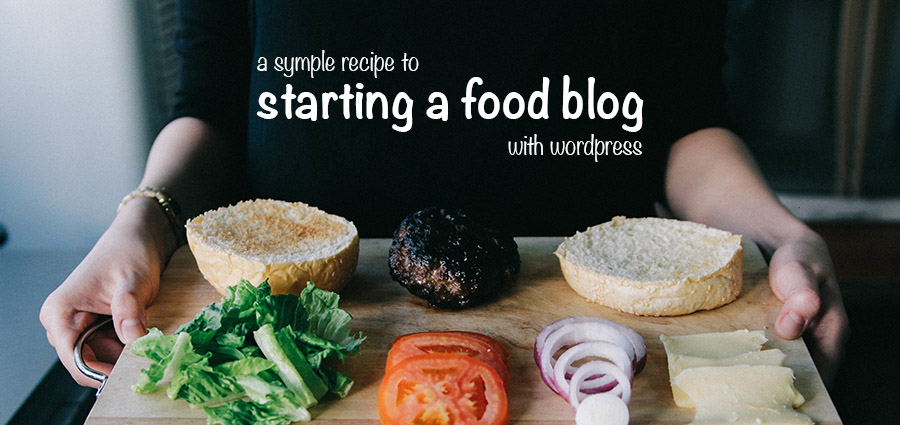
If you are an aspiring chef, passionate about healthy living or just love eating, you may have thought about writing a food blog. But while writing about something you love seems obvious, you may not know how to get started.
It may not seem as simple to you as whipping up your trademark meal in the kitchen, but starting a food blog is easier than you think. WordPress is the perfect Content Management System (CMS) for food bloggers because it’s easy to set up and there are loads of resources available to get you started.
In this article, we will take you through the necessary steps to set up your own food blog and start sharing your passion with the world. But before that, we’ll start with a couple of examples of excellent food blogs in the wild.
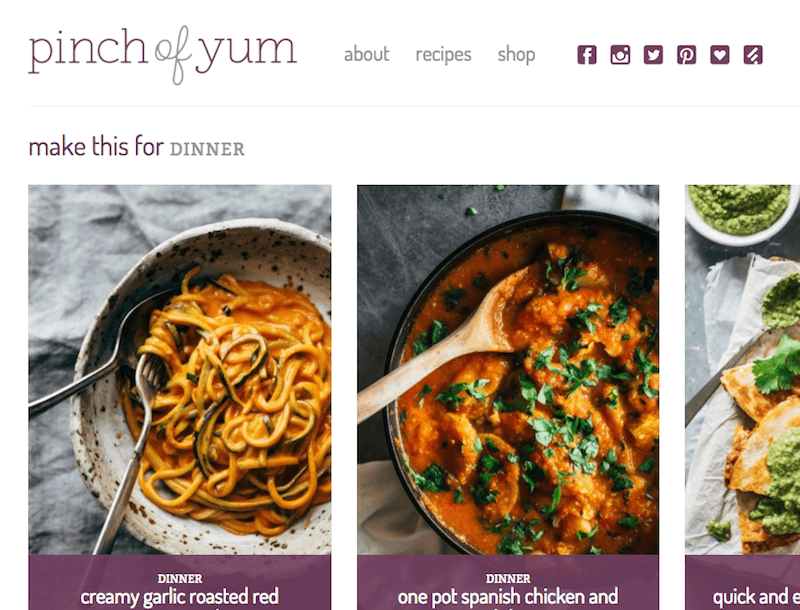
Pinch of Yum is a beautiful food blog by a former fourth grade teacher.
There are so many food blogs available now that it is difficult to choose a couple of favorites. The best food blogs all have a few things in common though: They are beautiful to look at, with great photography, and are filled with passion.
The Minimalist Baker is all about quick and easy recipes with few ingredients and Pinch of Yum shares practical, interesting, and delicious recipes of all kinds. These two alone can offer all sorts of inspiration, and naturally, they both run on WordPress!
What You’ll Need for Your Food Blog
Now that we’ve given you some added inspiration, let’s take a quick look at what you will need:
- WordPress. This is an obvious one – you’ll need it installed either locally or on your web server.
- A Theme. Below we will list some of food blog specific themes and a multipurpose option, all of which could work for you. Just choose one that suits your taste.
- Plugins. We’re going to tell you what plugins you should consider adding to your website.
- Beautiful Photography. You’ll want plenty of pictures of your food, and we will show you how to make sure they don’t bog down your site.
Sounds simple, right? Let’s go!
1. Set Up Your Blog
We have other articles about setting up a blog, but here’s the short and sweet version. The first step is to get an instance of WordPress running either locally or online.
If you want to jump right into getting WordPress hosting, we highly recommend WP Engine for managed hosting. They deal with the server including installs, backups and updates so you don’t have to. Their packages start at $29 per month. Flywheel is another managed WordPress host with similar features, but priced at $15 per month, so it’s great if you are on a budget. If you are really strapped for cash and want to start small, check out Bluehost, which starts at $3.49 per month and includes a quick install option for WordPress.
All of these hosting companies either offer WordPress already installed, or a quick 1-click installation. So with WordPress set up, what’s next? Let’s take a look at themes.
2. Choose a Theme
To save yourself some trouble down the line, be sure to look around at a few different themes before starting, rather than picking the first one you see.
When looking for a theme for your food blog, consider the layout, how customizable it is, and how it uses images. If you are thinking about purchasing a theme (which we recommend), check out our tips for buying the perfect WordPress theme. Here are a free great food blog themes you could consider.
Veggie
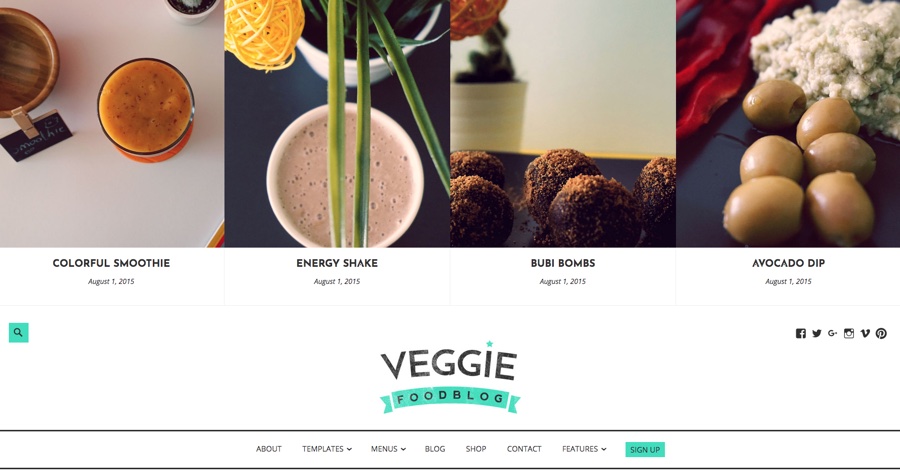
Veggie is a powerful contemporary blogging theme suitable for a variety of blogging subjects. From lifestyle and recipe blogs to fashion and tech blogs this theme will make a great job presenting your content in the best light possible. Its modern and mobile friendly responsive design will make your site look good in the eyes of Google and that’s a must for SEO.
Veggie, like our other themes, is built using standard WordPress features. So, there is no need for heavy page builder plugins to create layouts presented in the demo. As it is a niche theme, it is not bloated with ton of unnecessary features that won’t be used, but concentrates on the features a modern blog site needs.
There are 6 blog layout options, 3 header options, color options, custom widgets that can be used to build different front page layouts and of course there are a couple of nicely styled page templates for inner pages. Veggie also visually supports WooCommerce plugin that makes creating an online shop a breeze. And it also comes with premium version of Soliloquy slider that can be used to create wonderful image or video slides.
Chow
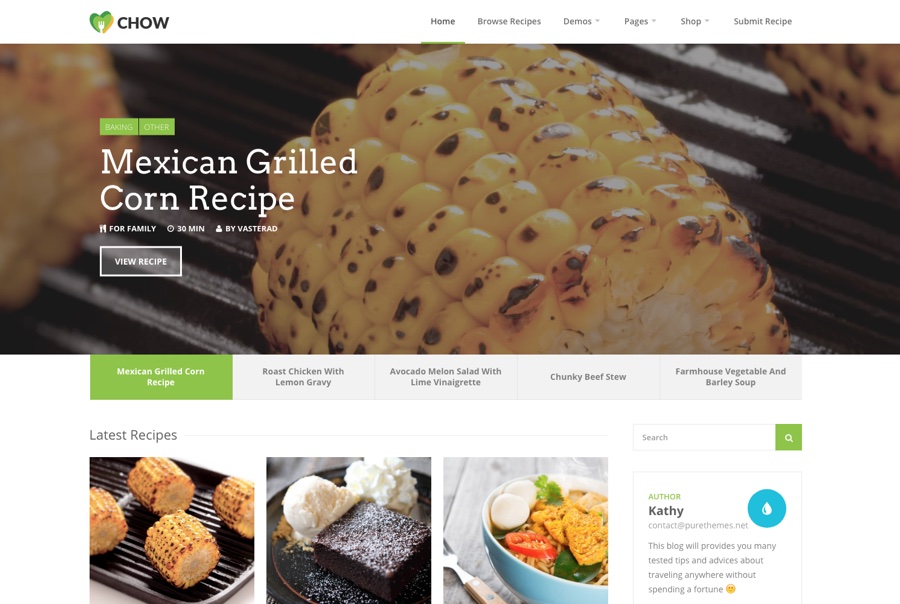
Chow is a delicious recipe and food blog premium WordPress theme. This lovely and minimal theme is a great way to share your favorite recipes with the world.
If you’re a foodie, you’ve probably collected quite a few delicious recipes over the years. So why not start a food blog where you can share your love of all things yummy? Chow is a great way to add your recipes, and allows readers to share their own, on your site! The built-in FoodiePress recipe editor makes it easy to add ingredients, instructions and customize the recipe layout.
The theme is also fully integrated with Schema.org and hRecipe so your recipes look great in search results (which is super important, since this is how many new readers are going to find your site). Plus, the theme includes page templates and post formats to help get your site setup quick. Other theme features of Chow include the CodaSlider, FlexSlider, custom color schemes, font options, localization support and more.
Daily Dish
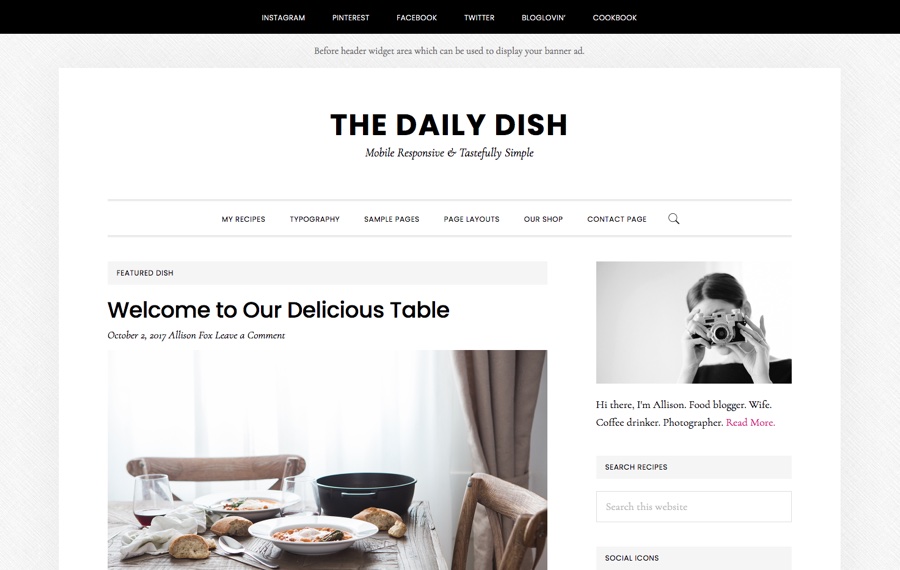
Daily Dish is a lovely food blog premium WordPress theme from StudioPress that is a child theme for the powerful Genesis Framework. This theme is a perfect fit for your next blog. Share recipes, blog about nutrition and health, spread the word about eating organic or explore gourmet eateries in town. Whatever your foodie passion, it’s easy to get your blog up and running in no time at all with the Daily Dish WordPress theme.
This theme is a lovely, minimal blogging WordPress theme. It’s clean and simple. Plus, since it is a Genesis Child theme this means that Daily Dish comes with all of the great features you’d expect from this framework – including custom menus, multi-column layouts, custom backgrounds and plenty of theme options.
Florentine
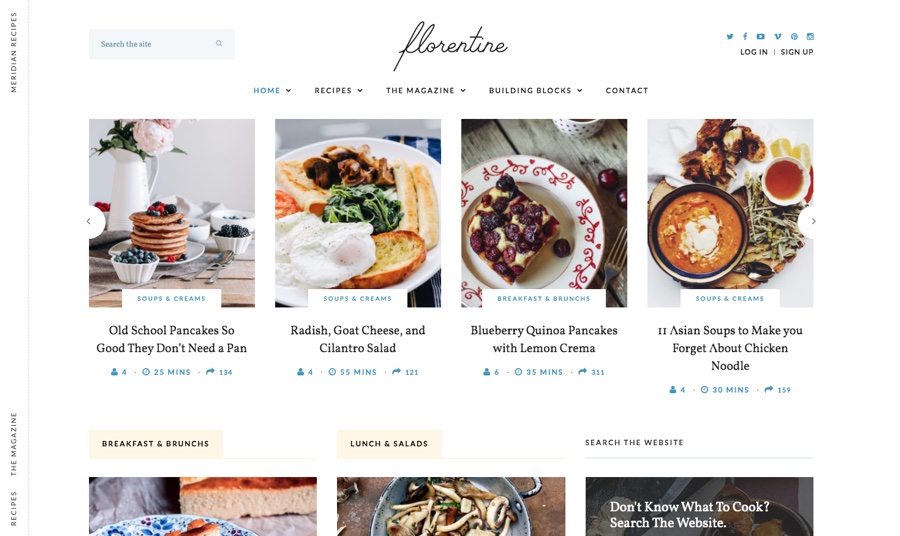
Meridian Recipes is a stunning, feature-rich, fully responsive WordPress theme for food bloggers. You don’t need to worry about your food blog looking like everyone else’s as Meridian Recipes has endless customization options to explore.
There are 19 different modules that you can combine to make your homepage look precisely how you want it to and there are even more customization options available with the MeridianStyler. Using the MeridianStyler, you can change almost anything about any of your elements – color, typography, background, and more. You can easily create a unique website without having a background in design. And no coding skills are required either!
Meridian Recipes is a full-featured theme with its own 5-star rating and bookmarking system. Your visitors can create an account on your site and easily track the recipes they’ve rated or bookmarked.
Other great, visitor friendly features are print-friendly recipes and distraction free cook-mode. Not everyone has a device they can use while cooking and Meridian Recipes makes it easy to print a clean looking recipe that’s perfect to cook from. Cook-mode is for those that do cook from their device – it removes all the distracting elements from the page so that your reader can follow your recipe without missing any essential steps or ingredients.
Food Blogger
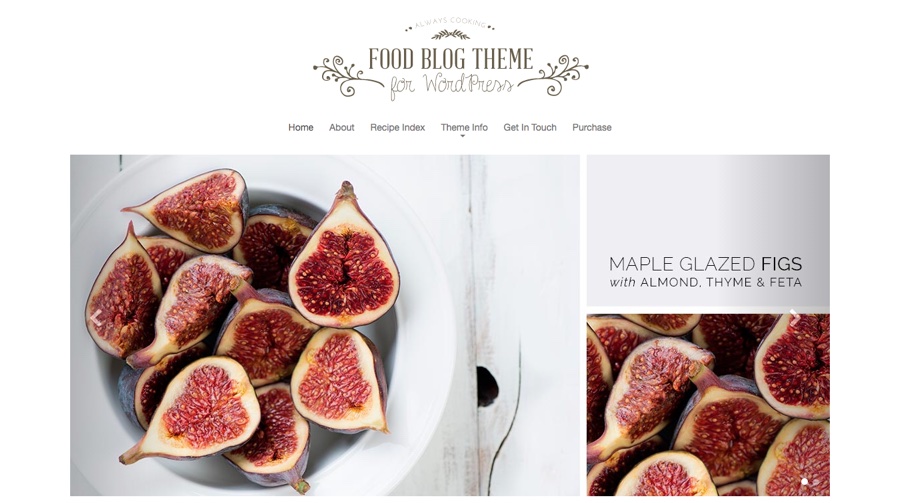
Food Blog from Nimbus Themes is one of the top choices when it comes to food blogs, mainly because it has a photo-friendly layout that makes your content stand out. The theme also integrates perfectly with the Recipe Card plugin which makes creating recipes a breeze.
The header area features a beautiful slider to promote your latest recipes and the two-column layout ensures your sidebar has plenty of widget space. A recipe index page is also available so your visitors can easily browse through different categories and find recipes that interest them the most.
The Food Blog theme features fully responsive design that looks great on just about any device and each post has links to next and previous posts which is sure to keep visitors on your site for a longer period of time. Social media icons are included for sharing your content and building your following. The advanced theme options panel makes customizing the theme a breeze and you can take the customization a step further thanks to the custom CSS section. Finally, the theme includes ongoing updates, SEO optimized code, and top notch security.
Total
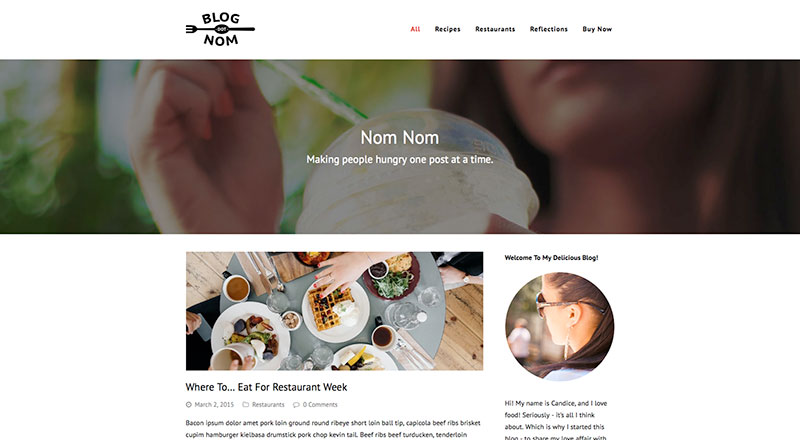
This is a more general theme framework, but it is designed to be multipurpose and can easily be used to create a beautiful food blog. Check out our food blogger theme demo! With Total your possibilities are endless.
The theme features more than 500+ easy to customize settings in the WordPress live customizer, as well as 80+ page builder modules. This includes a handy menu leader items module, custom heading, image galleries and carousels, social sharing and tons more. Plus the theme is SEO optimized and fully responsive.
For more inspiration and tons of theme options, check out Themeforest or Creative Market. Just do a quick search for food blog. You’re sure to find one you love.
3. Install Plugins
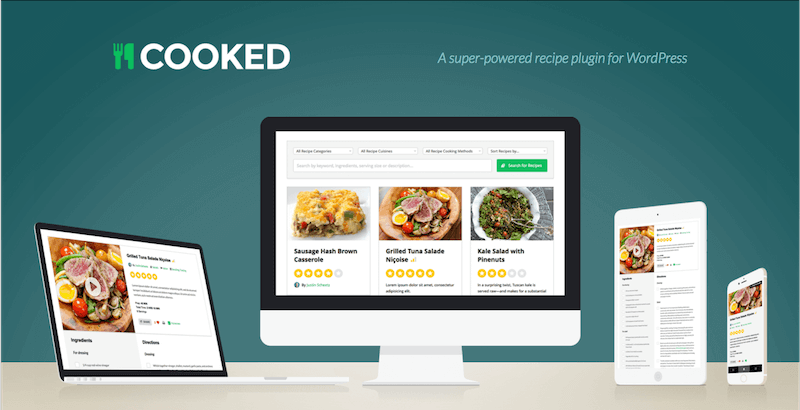
Cooked is a super powerful recipe plugin.
One of the best things about using WordPress is the wide range of plugins available to add functionality to your site. We recommend some basic plugins that you should consider installing and activating to get the most out of your site, such as Yoast SEO for search engine optimization and Akismet for spam protection. We cover a few other options in our article on how to get started blogging.
You can start a food blog and just write about food, but depending on your website goals, you may want to consider offering detailed recipes. WordPress, unsurprisingly, has some plugins that can help you do just that:
- WP Ultimate Recipe. Easily add recipes to WordPress posts and pages and enable your visitors to adjust the number of servings, print the recipe, and find other recipes using a specific ingredient.
- Zip Recipes. Add elegant recipes that automatically use a search engine friendly format making them easier to find.
4. Add Good Images
A huge part of enjoying food is the visual presentation, which is why food styling is a real thing. No food blog is complete without images of food – even if it’s brand new – so you need to make sure you have lots of beautiful images to show off your culinary treats.
The challenge with including images is that they can take a up a lot of space and slow down your website. And with many people browsing on their mobile devices, websites need to be small and fast. Luckily for you, there are ways to optimize images so they take up as little space as possible.
In a nutshell, image optimization starts with using the right dimensions and the right format for your needs. It’s a pretty big (but not overcomplicated topic, so don’t forget it. There are also several WordPress plugins you can use to help optimize image performance.
Creating a food blog isn’t hard, and using WordPress makes it even easier. You can get started very quickly and have a beautiful site in no time. If you followed along with us, you should be just about ready to launch your magnificent food blog to the world. Of course, we will leave the food part to you.
If you have any questions or suggestions or think we left out something, please let us know in the comments. Did you set up a food blog based on our tips? We would love to see it, so share the link below!




Thanks John, for creating such a helpful post. You explained everything such a way that one can set up other topic related blog rather than food blog easily.
Thanks, Ishtiak!
Food is really an amazing topic for blogs, and would really be perfect to use WordPress on it 🙂
Thank you so much for posting this useful information! I am just starting to set up my blog and this guide has been invaluable and made the whole process much less intimidating. I was thrilled to find a resource that broke down the process in an easy step-by-step manner.
Hi, it’s really helpful information my friend wants to make a food blog but the problem is we are very bad in content writing for the blog. Is there any solution to overcome content writing problem??
If you want to improve our own writing, there’s not better way than to practice 🙂 But if you want to hand off the task, you could try asking folks on Yelp if they’d like to write a review, or reach out to friends who are foodies. If you wand to work with professional writers, I found a site called iWriter that has very reasonable prices. I haven’t tried it myself yet, but it looks like a good option for a new blog that needs to build up a bit of content. Best of luck with your food blog!
I am going to start a food blog and cannot express my gratitude enough for the content on this site. I now have an idea where to start and lots of plugins I plan to try on my blog.
Hi,
Your guide on starting a successful food blog with WordPress is a recipe for digital triumph! It’s packed with essential ingredients and insights for culinary bloggers. Thanks for sharing the roadmap to our blogging dreams!